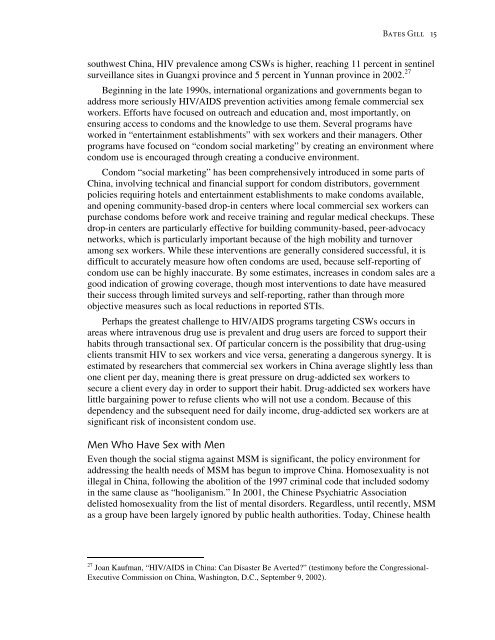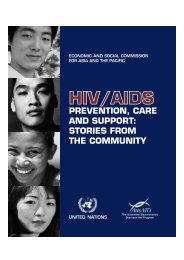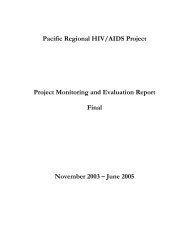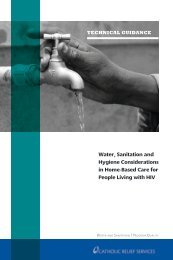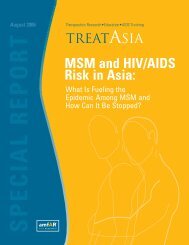Assessing HIV/AIDS Initiatives in China - Center for Strategic and ...
Assessing HIV/AIDS Initiatives in China - Center for Strategic and ...
Assessing HIV/AIDS Initiatives in China - Center for Strategic and ...
You also want an ePaper? Increase the reach of your titles
YUMPU automatically turns print PDFs into web optimized ePapers that Google loves.
Bates Gill 15<br />
southwest Ch<strong>in</strong>a, <strong>HIV</strong> prevalence among CSWs is higher, reach<strong>in</strong>g 11 percent <strong>in</strong> sent<strong>in</strong>el<br />
surveillance sites <strong>in</strong> Guangxi prov<strong>in</strong>ce <strong>and</strong> 5 percent <strong>in</strong> Yunnan prov<strong>in</strong>ce <strong>in</strong> 2002. 27<br />
Beg<strong>in</strong>n<strong>in</strong>g <strong>in</strong> the late 1990s, <strong>in</strong>ternational organizations <strong>and</strong> governments began to<br />
address more seriously <strong>HIV</strong>/<strong>AIDS</strong> prevention activities among female commercial sex<br />
workers. Ef<strong>for</strong>ts have focused on outreach <strong>and</strong> education <strong>and</strong>, most importantly, on<br />
ensur<strong>in</strong>g access to condoms <strong>and</strong> the knowledge to use them. Several programs have<br />
worked <strong>in</strong> “enterta<strong>in</strong>ment establishments” with sex workers <strong>and</strong> their managers. Other<br />
programs have focused on “condom social market<strong>in</strong>g” by creat<strong>in</strong>g an environment where<br />
condom use is encouraged through creat<strong>in</strong>g a conducive environment.<br />
Condom “social market<strong>in</strong>g” has been comprehensively <strong>in</strong>troduced <strong>in</strong> some parts of<br />
Ch<strong>in</strong>a, <strong>in</strong>volv<strong>in</strong>g technical <strong>and</strong> f<strong>in</strong>ancial support <strong>for</strong> condom distributors, government<br />
policies requir<strong>in</strong>g hotels <strong>and</strong> enterta<strong>in</strong>ment establishments to make condoms available,<br />
<strong>and</strong> open<strong>in</strong>g community-based drop-<strong>in</strong> centers where local commercial sex workers can<br />
purchase condoms be<strong>for</strong>e work <strong>and</strong> receive tra<strong>in</strong><strong>in</strong>g <strong>and</strong> regular medical checkups. These<br />
drop-<strong>in</strong> centers are particularly effective <strong>for</strong> build<strong>in</strong>g community-based, peer-advocacy<br />
networks, which is particularly important because of the high mobility <strong>and</strong> turnover<br />
among sex workers. While these <strong>in</strong>terventions are generally considered successful, it is<br />
difficult to accurately measure how often condoms are used, because self-report<strong>in</strong>g of<br />
condom use can be highly <strong>in</strong>accurate. By some estimates, <strong>in</strong>creases <strong>in</strong> condom sales are a<br />
good <strong>in</strong>dication of grow<strong>in</strong>g coverage, though most <strong>in</strong>terventions to date have measured<br />
their success through limited surveys <strong>and</strong> self-report<strong>in</strong>g, rather than through more<br />
objective measures such as local reductions <strong>in</strong> reported STIs.<br />
Perhaps the greatest challenge to <strong>HIV</strong>/<strong>AIDS</strong> programs target<strong>in</strong>g CSWs occurs <strong>in</strong><br />
areas where <strong>in</strong>travenous drug use is prevalent <strong>and</strong> drug users are <strong>for</strong>ced to support their<br />
habits through transactional sex. Of particular concern is the possibility that drug-us<strong>in</strong>g<br />
clients transmit <strong>HIV</strong> to sex workers <strong>and</strong> vice versa, generat<strong>in</strong>g a dangerous synergy. It is<br />
estimated by researchers that commercial sex workers <strong>in</strong> Ch<strong>in</strong>a average slightly less than<br />
one client per day, mean<strong>in</strong>g there is great pressure on drug-addicted sex workers to<br />
secure a client every day <strong>in</strong> order to support their habit. Drug-addicted sex workers have<br />
little barga<strong>in</strong><strong>in</strong>g power to refuse clients who will not use a condom. Because of this<br />
dependency <strong>and</strong> the subsequent need <strong>for</strong> daily <strong>in</strong>come, drug-addicted sex workers are at<br />
significant risk of <strong>in</strong>consistent condom use.<br />
Men Who Have Sex with Men<br />
Even though the social stigma aga<strong>in</strong>st MSM is significant, the policy environment <strong>for</strong><br />
address<strong>in</strong>g the health needs of MSM has begun to improve Ch<strong>in</strong>a. Homosexuality is not<br />
illegal <strong>in</strong> Ch<strong>in</strong>a, follow<strong>in</strong>g the abolition of the 1997 crim<strong>in</strong>al code that <strong>in</strong>cluded sodomy<br />
<strong>in</strong> the same clause as “hooliganism.” In 2001, the Ch<strong>in</strong>ese Psychiatric Association<br />
delisted homosexuality from the list of mental disorders. Regardless, until recently, MSM<br />
as a group have been largely ignored by public health authorities. Today, Ch<strong>in</strong>ese health<br />
27 Joan Kaufman, “<strong>HIV</strong>/<strong>AIDS</strong> <strong>in</strong> Ch<strong>in</strong>a: Can Disaster Be Averted?” (testimony be<strong>for</strong>e the Congressional-<br />
Executive Commission on Ch<strong>in</strong>a, Wash<strong>in</strong>gton, D.C., September 9, 2002).


